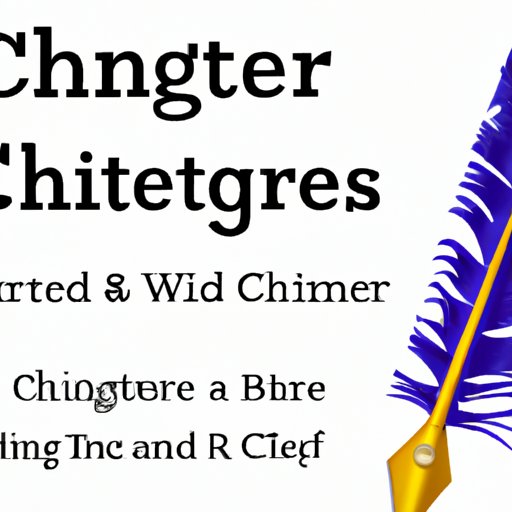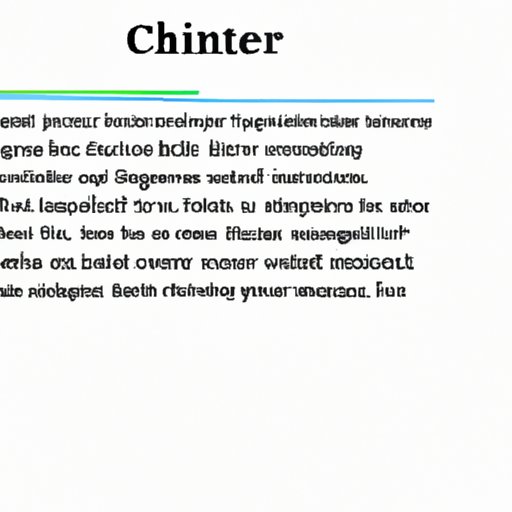Introduction
A clincher in writing is a powerful statement at the end of a paragraph or essay that summarizes the main point of the piece. It is often used to tie up loose ends and leave readers with something to think about. Clinchers can be used to emphasize a point or provide a sense of closure. They are an important tool for writers and can help make a piece of writing more compelling and memorable.
This article will explore what is a clincher in writing and provide a guide to crafting the perfect clincher sentences. It will discuss different types of clinchers, the benefits of using them, and offer tips and strategies for making your clincher stand out. Examples of clinchers will also be provided.
A Guide to Writing Clinchers: What They Are and How to Use Them
Clinchers are sentences or phrases used to effectively summarize a piece of writing. They should be concise, direct, and memorable. Clinchers can be used to add impact to a piece of writing, emphasize a point, or draw a conclusion.
Different types of clinchers include rhetorical questions, quotes, call to actions, and summary statements. Rhetorical questions are used to engage readers and make them think about the topic. Quotes can be used to emphasize a point or lend credibility to an argument. Call to actions can be used to encourage readers to take action. Summary statements can be used to concisely sum up the main points of a piece of writing.
The benefits of using clinchers in writing include increasing reader engagement, emphasizing key points, and providing a sense of closure. By adding a clincher to your writing, you can ensure that readers remember your message and take away something from it. It can also help make your writing more persuasive and effective.
Examples of clinchers include: “It’s time to take action”; “The answer is clear”; “The choice is yours”; and “We can all make a difference”.

Crafting the Perfect Clincher: Tips and Strategies for Writers
When crafting a clincher, it is important to understand your audience and make sure your clincher is relevant to their needs. You should also keep it short and sweet, as clinchers should be concise and direct. Utilizing strong language is also important, as this can help make your clincher more impactful and memorable. Additionally, creating a sense of urgency can help engage readers and encourage them to take action.
The Power of the Clincher: How to Make Your Writing Stand Out
Using emotional appeal and asking questions are two effective ways to make your writing stand out. Emotional appeals can evoke feelings in readers and make them more likely to take action. Questions can help engage readers and make them think about the topic. Establishing credibility is also important, as this can help make your writing more persuasive and convincing.

Writing the Most Effective Clincher Sentences
Choosing the right words is essential when writing clincher sentences. Words should be chosen carefully in order to create the desired effect. Building momentum is also important, as this can help increase reader engagement and interest. Furthermore, it is important to connect ideas in order to make your clincher cohesive and effective.
5 Ways You Can Write an Attention-Grabbing Clincher
One way to write an attention-grabbing clincher is to offer a solution. This can help make your writing more persuasive and encourage readers to take action. Making a bold statement is another way to grab readers’ attention. Asking a question is a great way to engage readers and make them think about the topic. Presenting a challenge can also be effective, as this can help motivate readers to take action. Finally, leading to further action can be a great way to end a piece of writing.
Writing a Clincher: Examples and Best Practices
Examples of good clinchers include: “We have the power to make a change”; “Take the first step today”; and “It’s time to take control”. When writing a clincher, it is important to make sure it is relevant to the topic and that it ties up loose ends. Additionally, it is important to make sure your clincher is concise and direct. Finally, it is important to choose words carefully in order to create the desired effect.

How to Write a Convincing Clincher in Your Writing
In order to write a convincing clincher, it is important to understand the topic and what you are trying to accomplish. Creating a clear call to action is also important, as this can help motivate readers to take action. Finally, using powerful language can help make your clincher more impactful and memorable.
Conclusion
Clinchers are an important tool for writers and can help make a piece of writing more compelling and memorable. Different types of clinchers include rhetorical questions, quotes, call to actions, and summary statements. When crafting a clincher, it is important to understand your audience and make sure it is relevant to their needs. Additionally, it is important to keep it short and sweet, use strong language, and create a sense of urgency. Examples of good clinchers include: “We have the power to make a change”; “Take the first step today”; and “It’s time to take control”.
Clinchers can be a great way to make your writing stand out and leave readers with something to think about. By understanding what a clincher is and how to use it effectively, you can ensure that your writing is more persuasive and memorable.
(Note: Is this article not meeting your expectations? Do you have knowledge or insights to share? Unlock new opportunities and expand your reach by joining our authors team. Click Registration to join us and share your expertise with our readers.)
